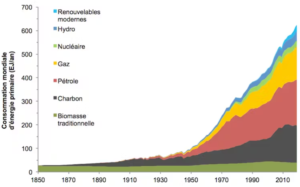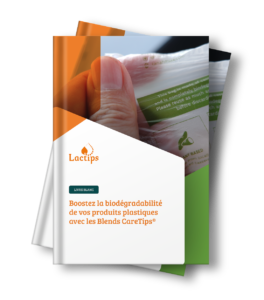In the face of environmental challenges, we urgently need to move away from our dependence on fossil fuels, particularly petroleum. Fortunately, the packaging industry now has a range of alternative bio-based and biodegradable solutions.
Bio-based food packaging
| Bio-based plastic: definition
According to the NF EN 16575 standard, a bio-based product is:
|
What are some potential solutions for switching to petroleum-free packaging?
- Recyclable paper and cardboard
Paper/cardboard is made from cellulose. This material is therefore the main example of bio-based packaging and has the advantage of being highly recyclable. There has also been an increase in its use since the use of plastic secondary packaging for fruit and vegetables was banned in January 2022.
Examples: Greaseproof paper and cardboard for takeaway food, biscuit and chocolate packaging, etc.
- PLA
Polylactic acid, or PLA, is a polyester-type biopolymer of plant origin produced via the lactic fermentation of a sugar.
This sugar is generally corn starch, but it can also be extracted from sugar cane, wheat or beetroot.
It is currently the best-known and most widely used bio-based plastic.
Examples: Thermoformed PLA trays for packaging foods with a short shelf life. PLA yoghurt cups.
- Other bio-based materials and innovations
There are other bio-based plastics, some of which are also biodegradable: these include PHAs and PBS.
Innovation also plays an important role in the search for new bio-based polymers, as any material derived from biomass can be used: microalgae, lignin, tannins, fatty acids, milk proteins, etc.
The advantages of bio-based solutions
- Reducing our dependence on petroleum
Petroleum-based polymers consume 44 million tonnes of petroleum every year in Europe alone!

Unlike fossil fuels, the use of biomass was an integral part of a sustainable world – a world from which we departed!
Source: The conversation
Extending the use of bio-based materials would therefore avoid the need to use petroleum and would provide the possibility of a plastics economy that would be less dependent on petroleum prices, while at the same time reducing the resource’s payback period.
- Using renewable resources
Bio-based materials are renewable, meaning that they can be regenerated for new uses on a human time scale. Of course, to be virtuous, the exploitation of bio-based resources must be sustainable and rational and must not lead to deforestation.
| The recent “ReShaping Plastics” study has shaken up the plastics industry, showing that the measures taken to recycle and reduce the use of certain single-use plastics will not achieve the targets set.
In addition to recycling and reuse, the use of bio-based materials as a substitute for petroleum-based materials is an obvious solution, particularly for packaging. Source: https://plasticseurope.org/wp-content/uploads/2022/04/SYSTEMIQ-ReShapingPlastics-April2022.pdf
Evidence of the toxicity of microplastics Scientific evidence of the toxicity of microplastics is beginning to emerge. Some studies suggest, among other things, that:
https://www.foodpackagingforum.org/news/microplastics-can-lead-to-behavioral-changes-in-mice https://www.foodpackagingforum.org/news/researchers-detect-microplastics-in-human-semen-and-heart https://www.foodpackagingforum.org/news/two-studies-associate-microplastic-exposure-with-cancer |
Biodegradable food packaging
What plastics are biodegradable?
- PHAs (Polyhydroxyalkanoates)
PHAs are biodegradable and are obtained via the bacterial fermentation of sugars (generally starch) or lipids, i.e. vegetable oils such as rapeseed oil.
Example: Cosmetics manufacturer RIMAN is looking to replace its ABS caps with a PLA-PHA blend1.
- PBS (Polybutylene succinate)
This aliphatic polyester has properties similar to those of polyolefins. At present, 35% of it comes from renewable resources, and it has the advantage of being biodegradable under industrial composting conditions.
Examples: Single-use coffee capsules, food trays, compostable bags
- Biodegradable PLA
As well as being bio-based, PLA also has the advantage of being biodegradable, because it can be composted at high temperatures, i.e. in an industrial environment. Although not all PLA can be composted.
- Innovation in biodegradable polymers
The search for new biodegradable, bio-based and sustainable solutions is mobilising researchers around the world. Here are a few innovations:
- Bioplastics made from microalgae and green algae collected on beaches2
- Edible polymers containing casein and other proteins
- Biodegradable lignocellulose-based polymers
The advantages of biodegradable solutions
- Compostability
The biodegradability of these polymers means they could potentially be compatible with industrial or domestic composting.
If these polymers are both bio-based and biodegradable, this return to nature becomes part of a virtuous circle, contributing in particular to the re-carbonisation of soils worn down by intensive agriculture3. In this way, the carbon cycle is neither slowed down nor blocked.
- Reducing pollution
Water4 contamination by nano-, micro- and macroplastics is reaching critical levels. The use of polymers that are truly biodegradable in water appears to be necessary for many applications, particularly fishing.
Widespread adoption of bioplastics and biopolymers: what challenges are we facing?
A European legal framework is urgently needed
The European Commission considers that a legal framework needs to be established to specify the extent to which these bio-based, biodegradable and compostable plastics can be part of a sustainable future.
As far as composting is concerned, ANSES recommends banning compostable plastics from domestic composting, in the absence of sufficient standardisation.
ANSES is therefore proposing the introduction of a single, mandatory standard for products made from plastics claiming to be biodegradable or compostable.
A need to “educate” consumers
The growing use of biodegradable plastics is currently the subject of debate, not least because of the risk of confusion on the part of consumers. They could be encouraged to dispose of their biodegradable waste in the environment, which is clearly undesirable.
That being said, recycling cannot be seen as the only solution, as some waste that is “lost” in nature will never be recovered for recycling. For these specific applications5, the use of biodegradable polymers is much more realistic!
What does the future hold for sustainable food packaging?
A clearly defined regulatory and normative framework is still lacking, which is holding back the adoption of sustainable packaging solutions.
Nevertheless, although bioplastics only account for a small proportion of packaging, their use is set to increase sharply in the coming years, particularly with the separate collection of bio-waste becoming mandatory from 2024. In Italy, where separate collection has already been in place since 2022, the collection of compostable bioplastics is presented as a model of Italian excellence6.
PLA, PHA and PBS are currently the best-known bio-based and biodegradable polymers. Thanks to innovation, ever more effective solutions are emerging, suggesting that petroleum will no longer be used in the food packaging sector in the not too distant future.
With its 100% bio-based and 100% biodegradable solution, made from milk proteins, Lactips wants to contribute to this objective!
Do you want to boost the biodegradability of your plastic products?
1 https://www.usinenouvelle.com/article/partenariat-coreen-dans-les-bioplastiques.N2172397
2 https://www.lesechos.fr/weekend/planete/eranova-du-bioplastique-a-base-dalgues-vertes-1915204
3 https://www.lesechos.fr/idees-debats/sciences-prospective/climat-et-si-on-cultivait-du-carbone-1396673
4 and air, clouds, mountains, soil, etc.
5 Golf tees, horticultural and agricultural equipment, etc
6 https://eng.biorepack.org/communication/press-releases/compostable-bioplastics-food-waste-collection-model.kl



